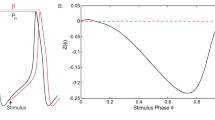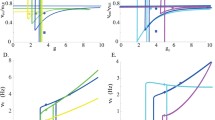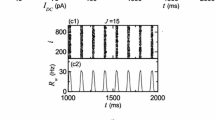Abstract
We study the spatiotemporal dynamics of a two-dimensional excitatory neuronal network with synaptic depression. Coupling between populations of neurons is taken to be nonlocal, while depression is taken to be local and presynaptic. We show that the network supports a wide range of spatially structured oscillations, which are suggestive of phenomena seen in cortical slice experiments and in vivo. The particular form of the oscillations depends on initial conditions and the level of background noise. Given an initial, spatially localized stimulus, activity evolves to a spatially localized oscillating core that periodically emits target waves. Low levels of noise can spontaneously generate several pockets of oscillatory activity that interact via their target patterns. Periodic activity in space can also organize into spiral waves, provided that there is some source of rotational symmetry breaking due to external stimuli or noise. In the high gain limit, no oscillatory behavior exists, but a transient stimulus can lead to a single, outward propagating target wave.














Similar content being viewed by others
References
Abbott, L. F., Varela, J. A., Sen, K., & Nelson, S. B. (1997). Synaptic depression and cortical gain control. Science, 275, 220–224.
Amari, S. (1977). Dynamics of pattern formation in lateral-inhibition type neural fields. Biological Cybernetics, 27, 77–87.
Bao, S., Chang, E. F., Davis, J. D., Gobeske, K. T., & Merzenich, M. M. (2003). Progressive degradation and subsequent refinement of acoustic representations in the adult auditory cortex. Journal of Neuroscience, 23, 10765–10775.
Bart, E., Bao, S., & Holcman, D. (2005). Modeling the spontaneous activity of the auditory cortex. Journal of Computational Neuroscience, 19, 357–378.
Benda, J., & Herz, A. V. M. (2003). A universal model for spike-frequency adaptation. Neural Computation, 15, 2523–2564.
Benucci, A., Frazor, R. A., & Carandini, M. (2007). Standing waves and traveling waves distinguish two circuits in visual cortex. Neuron, 55, 103–117.
Buszaki, G. (2006). Rhythms of the brain. Oxford: Oxford University Press.
Buszaki, G., & Draguhn, A. (2004). Neuronal oscillation in cortical networks. Science, 304, 1926–1929.
Chervin, R. D., Pierce, P. A., & Connors, B. W. (1988). Periodicity and directionality in the propagation of epileptiform discharges across neocortex. Journal of Neurophysiology, 60, 1695–1713.
Delaney, K., Gelperin, A., Fee, M., Flores, J., Gervais, R., & Tank, D. (1994). Waves and stimulus-modulated dynamics in an oscillating olfactory network. Proceedings of the National Academy of Sciences of the United States of America, 91, 669–73.
Dudek, F. E., & Spitz, M. (1997). Hypothetical mechanisms for the cellular and neurophysiological basis of secondary epileptogenesis: Proposed role for synaptic reorganization. Journal of Clinical Neurophysiology, 14, 90–101.
Ermentrout, G. B. (1998). Linearization of f-I curves by adaptation. Neural Computation, 10, 1721–1729.
Ermentrout, G. B., & Kleinfeld, D. (2001). Traveling electrical waves in cortex: Insights from phase dynamics and speculation on a computational role. Neuron, 29, 33–44.
Folias, S. E., & Bressloff, P. C. (2004). Breathing pulses in an excitatory neural network. SIAM Journal on Applied Dynamical Systems, 3, 378–407.
Folias, S. E., & Bressloff, P. C. (2005a). Breathers in two-dimensional neural media. Physical Review Letters, 95, 208107.
Folias, S. E., & Bressloff, P. C. (2005b). Stimulus-locked traveling waves and breathers in an excitatory neural network. SIAM journal on Applied Mathematics, 65, 2067–2092.
Fung, C. C. A., Wong, K. Y. M., & Wu, S. (2008). Dynamics of neural networks with continuous attractors. EPL, 84, 18002.
Guo, Y., & Chow, C. C. (2005a). Existence and stability of standing pulses in neural networks: I. Existence. SIAM Journal on Applied Dynamical Systems, 4, 217–248.
Guo, Y., & Chow, C. C. (2005b). Existence and stability of standing pulses in neural networks: II. Stability. SIAM Journal on Applied Dynamical Systems, 4, 249–281.
Han, F., Caporale, N., & Dan, Y. (2008). Reverberation of recent visual experience in spontaneous cortical waves. Neuron, 60, 321–327.
Hansel, D., & Sompolinsky, H. (2001). Methods in neuronal modeling. In Modeling feature selectivity in local cortical circuits (2nd Ed., ch. 13, pp. 499–568). Cambridge: MIT.
Holcman, D., & Tsodyks, M. (2006). The emergence of Up and Down states in cortical networks. PLoS Computational Biology, 2, 174–181.
Huang, X., Troy, W. C., Yang, Q., Ma, H., Laing, C. R., Schiff, S. J., et al. (2004). Spiral waves in disinhibited mammalian neocortex. Journal of Neuroscience, 24, 9897–9902.
Hutt, A., Longtin, A., & Schimansky-Geier, L. (2008). Additive noise-induces Turing transitions in spatial systems with application to neural fields and the Swift-Hohenberg equation. Physica D, 237, 755–773.
Jung, P., & Mayer-Kress, G. (1995). Spatiotemporal stochastic resonance in excitable media. Physical Review Letters, 74, 2130–2133.
Kilpatrick, Z. P., & Bressloff, P. C. (2009). Effects of adaptation and synaptic depression on spatiotemporal dynamics of an excitatory neuronal network. Physica D. doi:10.1016/j.physd.2009.06.003.
Klimesch, W. (1999). EEG alpha and theta oscillations reflect cognitive and memory performance: A review and analysis. Brain Research Reviews, 29, 169–195.
Laing, C. R. (2005). Spiral waves in nonlocal equations. SIAM Journal on Applied Dynamical Systems, 4, 588–606.
Laing, C. R., Frewen, T. A., & Kevrekidis, I. G. (2007). Coarse-grained dynamics of an activity bump in a neural field model. Nonlinearity, 20, 2127–2146.
Laing, C. R., & Troy, W. C. (2003). PDE methods for nonlocal models. SIAM Journal on Applied Dynamical Systems, 2, 487–516.
Lakatos, P., Chen, C. M., O’Connell, M. N., Mills, A., & Schroeder, C. E. (2007). Neuronal oscillations and multisensory interaction in primary auditory cortex. Neuron, 53, 279–292.
Lam, Y. W., Cohen, L. B., Wachowiak, M., & Zochowski, M. R. (2000). Odors elicit three different oscillations in the turtle olfactory bulb. Journal of Neuroscience, 20, 749–62.
Lee, U., Kim, S., & Jung, K. Y. (2006). Classification of epilepsy types through global network analysis of scalp electroencephalograms. Physical Review E, 73, 041920.
Linder, B., Garcia-Ojalvo, J., Neiman, A., & Schimansky-Geier, L. (2004). Effects of noise in excitable systems. Physics Reports, 393, 321–424.
Matveev, V., & Wang, X. J. (2000). Implications of all-or-none synaptic transmission and short-term depression beyond vesicle depletion: A computational study. Journal of Neuroscience, 20, 1575–1588.
McNamara, J. O. (1994). Cellular and molecular basis of epilepsy. Journal of Neuroscience, 14, 3412–3425.
Melamed, O., Barak, O., Silberberg, G., Markram, H., & Tsodyks, M. (2008). Slow oscillations in neural networks with facilitating synapses, Journal of Computational Neuroscience, 25, 308–316.
Milton, J., & Jung, P. (2003). Epilepsy as a dynamic disease. Berlin: Springer.
Milton, J. G., Chu, P. H., & Cowan, J. D. (1993). Spiral waves in integrate-and-fire neural etworks. In S. J. Hanson, J. D. Cowan, & C. L. Giles (Eds.), Advances in neural information n processing systems (pp. 1001–1007). San Mateo: Morgan Kaufmann.
Owen, M. R., Laing, C. R., & Coombes, S. (2007). Bumps and rings in a two-dimensional neural field: splitting and rotational instabilities. New Journal of Physics, 9, 378.
Petersen, C. C. H., Grinvald, A., & Sakmann, B. (2003). Spatiotemporal dynamics of sensory responses in layer 2/3 of rat barrel cortex measured in vivo by voltage-sensitive dye imaging combined with whole-cell voltage recordings and neuron reconstructions. Journal of Neuroscience, 23(4), 1298–1309.
Pinto, D. J., & Ermentrout, G. B. (2001a). Spatially structured activity in synaptically coupled neuronal networks: I. Traveling fronts and pulses. SIAM journal on Applied Mathematics, 62, 206–225.
Pinto, D. J., & Ermentrout, G. B. (2001b). Spatially structured activity in synaptically coupled neuronal networks: II. Lateral inhibition and standing pulses. SIAM Journal on Applied Mathematics, 62, 226–243.
Prechtl, J. C., Cohen, L. B., Pesaran, B., Mitra, P. P., & Kleinfeld, D. (1997). Visual stimuli induce waves of electrical activity in turtle cortex. Proceedings of the National Academy of Sciences of the United States of America, 94, 7621–7626.
Roelfsema, P. R., Engel, A. K., Konig, P., & Singer, W. (1997). Visuomotor integration is associated with zero time-lag synchronization among cortical areas. Nature, 385, 1157–1161.
Rubin, J., & Bose, A. (2004). Localized activity patterns in excitatory neuronal networks. Network, 15, 133–158.
Schiff, S. J., Huang, X., & Wu, J. Y. (2007). Dynamical evolution of spatiotemporal patterns in mammalian middle cortex. Physical Review Letters, 98, 178102.
Schiff, S. J., Sauer, T., Kumar, R., & Weinstein, S. L. (2005). Neuronal spatiotemporal pattern discrimination: The dynamical evolution of seizures. Neuroimage, 28, 1043–1055.
Sederberg, P. B., Kahana, M. J., Howard, M. W., Donner, E. J., & Madsen, J. R. (2003). Theta and gamma oscillations during encoding predict subsequent recall. Journal of Neuroscience, 23, 10809–10814.
Shusterman, V., & Troy, W. C. (2008). From baseline to epileptiform activity: A path to synchronized rhythmicity in large-scale neural networks. Physical Review E, 77, 061911.
Singer, W., & Gray, C. M. (1995). Visual feature integration and the temporal correlation hypothesis. Annual Review of Neuroscience, 18, 555–586.
Stevens, C., & Wesseling, J. (1998). Activity-dependent modulation of the rate at which synaptic vesicles become available to undergo exocytosis. Neuron, 21, 415–424.
Tabak, J., Senn, W., O’Donovan, M. J., & Rinzel, J. (2000). Modeling of spontaneous activity in developing spinal cord using activity-dependent depression in an excitatory network. Journal of Neuroscience, 20, 3041–3056.
Troy, W. C. (2008). Traveling waves and synchrony in an excitable large-scale neuronal network with asymmetric connections. SIAM Journal on Applied Dynamical Systems, 7, 1247–1282.
Troy, W. C., & Shusterman, V. (2007). Patterns and features of families of traveling waves in large-scale neuronal networks. SIAM Journal on Applied Dynamical Systems, 6, 263–292.
Tsodyks, M. S., & Markram, H. (1997). The neural code between neocortical pyramidal neurons depends on neurotransmitter release probability. Proceedings of the National Academy of Sciences of the United States of America, 94, 719–723.
Tsodyks, M. S., Pawelzik, K., & Markram, H. (1998). Neural networks with dynamic synapses. Neural Computation, 10, 821–835.
Wang, X. J. (1998). Calcium coding and adaptive temporal computation in cortical pyramidal neurons. Journal of Neurophysiology, 79, 1549–1566.
Wang, X. J. (1999). Synaptic basis of cortical persistent activity: the importance of NMDA receptors to working memory. Journal of Neuroscience, 19, 9587–9603.
Wu, J. Y. (2008). Propagating waves of activity in the neocortex: What they are, what they do. Neuroscientist, 14, 487–502.
Wu, J. Y., Guan, L., & Tsau, Y. (1999). Propagating activation during oscillations and evoked responses in neocortical slices. Journal of Neuroscience, 19, 5005–5015.
Wu, S., Hamaguchi, K., & Amari, S.-I. (2008). Dynamics and computation of continuous attractors. Neural Computation, 20, 994–1025.
Xu, W., Huang, X., Takagaki, K., & Wu, J. Y. (2007). Compression and reflection of visually evoked cortical waves. Neuron, 55, 119–129.
Zucker, R. S., & Regehr, W. G. (2002). Short-term synaptic plasticity. Annual Review of Physiology, 64, 355–405.
Acknowledgements
This publication was based on work supported in part by the National Science Foundation (DMS-0813677) and by Award No KUK-C1-013-4 made by King Abdullah University of Science and Technology (KAUST). PCB was also partially supported by the Royal Society-Wolfson Foundation. We would like to thank Carlo Laing for helpful conversations regarding numerical simulations. We also thank Bard Ermentrout for highlighting issues regarding bump stability calculations in the high-gain limit.
Author information
Authors and Affiliations
Corresponding author
Additional information
Action Editor: Bard Ermentrout
Rights and permissions
About this article
Cite this article
Kilpatrick, Z.P., Bressloff, P.C. Spatially structured oscillations in a two-dimensional excitatory neuronal network with synaptic depression. J Comput Neurosci 28, 193–209 (2010). https://doi.org/10.1007/s10827-009-0199-6
Received:
Revised:
Accepted:
Published:
Issue Date:
DOI: https://doi.org/10.1007/s10827-009-0199-6




